The Best Party Trick Ever: How to Make Thirty Minute Mozzarella
The following is a guest post from Andrew Wilder of Eating Rules. Welcome, Andrew!
A couple of years ago at a Fourth of July party, I pulled off one of my best party tricks ever.
Showing up with a gallon of milk in hand, I asked my friends if I could borrow their kitchen. Spying the other items in my bag — a bunch of fresh basil and cherry tomatoes — they knew I had something good in store. They eagerly let me take over.
Half an hour later, I emerged victorious from the kitchen with a platter of fresh caprese, made with still-warm mozzarella.
I’ve been using this “30-minute Mozzarella” recipe, from Ricki Carroll’s book, Home Cheese Making, for a few years now. I’ll admit, it comes out slightly different each time (the type of milk, how quickly you heat it, and how much you stretch it will affect both the flavor and texture), but it’s always been a big hit.
Homemade Mozzarella Tips & Tricks
1. This is a great recipe to make with kids. They’ll be completely mesmerized watching the milk curdle and turn into cheese — and it happens quickly enough to hold their attention. The last few steps can get pretty hot, so please do be careful when making this with children.
2. Do not use “Ultra-Pasteurized” milk for this recipe — it won’t curdle properly. If it says just “Pasteurized” on the container, you’re probably fine. Of course, you can also use raw milk instead, if that’s your thing (I’m not going to get into the pros and cons of raw vs. pasteurized milk — just remember that Ultra-Pasteurized is a dealbreaker.)
3. Depending on the fat percentage of your milk, you’ll get a very different cheese at the end. Whole milk produces a very rich, soft mozzarella, whereas 1% will make a harder, more string-cheese-like cheese. Fat free can get a bit too rubbery, so I don’t recommend it. I usually use 2%, which is what’s shown in the pictures here.
I’ve also made this recipe with goat’s milk, and it should work fine with sheep’s milk as well.
4. This recipe is a “shortcut” to mozzarella, since it uses a microwave to speed things along. If you don’t have a microwave, you can use a pot of very hot water and float a bowl in it instead. The goal is to get the curds hot so that they melt together and become stretchy like taffy. Also, the curds will get quite hot — it’s really helpful to have a pair of clean kitchen gloves to protect your hands.
Thanks go to my friend Sarah, who eagerly offered to model for the photos in exchange for some fresh mozzarella.
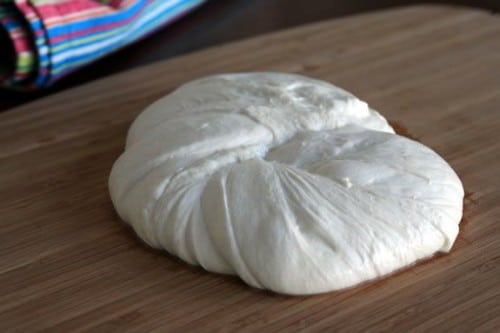
Recipe: Thirty Minute Mozzarella
You can probably find citric acid at a good grocery store, but rennet is harder to come by. You can order it online at several retailers; I’ve purchased it from New England Cheesemaking Supply and Grape and Granary.
You can also just get one of Ricki’s Mozzarella and Ricotta Cheese Making Kit, which have everything you need, including a dairy thermometer.
I prefer to use liquid vegetarian rennet, which New England Cheesemaking Supply sells at double-strength, so I use 1/8 tsp. for this recipe.
Ingredients
- 1 gallon Milk, not ultra-pasteurized
- 1 1/2 tsp. Citric Acid powder, dissolved in 1/4 cup room-temperature water
- 1/4 tsp. Liquid Rennet or 1/2 tablet Rennet, dissolved in 1/4 cup room-temperature water
- 1 tsp. Cheese (Flake) Salt or Kosher Salt
Instructions
1. Pour the milk in to a large pot. On medium-low, heat slowly to 55 degrees Fahrenheit. Stir slowly and continuously to keep from scalding.
2. Once the milk reaches 55 degrees, pour in the citric acid mixture and stir well. Keep heating.
3. When the milk hits 88 degrees, add the rennet mixture and stir well. Right around this time the milk will start to thicken, and you’ll see little white flecks stick to your spoon as it starts curdling.
4. Once the milk is in the 90-degree range, it should be noticeably curdled. Stir very gently at this point, if at all — you want to encourage the curds to knit together.
5. Between 95 and 105 degrees, the curds will be quite thick. Turn off the heat once they start separating from the sides of the pot, and there’s a very clear distinction between the curds (white clumps) and whey (yellow liquid).
6. Let the curds rest for 5 minutes.
7. With a perforated or slotted spoon, ladle the curds into a bowl. The curds will continue expelling whey once they’re in the bowl, which is fine. Once you have pulled most of the curds out of the pot (some little bits will probably still be floating about), pour any excess whey back in the pot.
8. Using a microwave, heat the curds for 60 seconds. Drain off any excess whey, then fold the curds over once, then once again. This is to distribute the heat evenly.
9. Microwave again for about 30-40 seconds, depending on the strength of your microwave. Pour off the whey.
10. Sprinkle the salt onto the cheese, and then fold the curds over twice again. Put them back into the microwave for another 30-40 seconds. Pour of any excess whey.
11. At this point, the cheese should be very hot, and look like melted mozzarella!
12. Stretch the cheese, and then fold it back on itself. If it tears when you try to stretch it, the cheese is not hot enough; just repeat the microwaving process. Stretch it again once or twice. If you want a more string-cheese like cheese, do it a few more times.
13. You can then twist or braid the cheese, or tear off pieces and roll them into small balls. If you’re going to refrigerate the cheese for later, drop it in a bowl of ice water to get the temperature down quickly. Otherwise, just dig in while it’s still warm!
Editor’s note: Don’t toss that whey! You can use it in pancakes or crepes.
What do you say, are you up for a ‘cheesy’ party trick?

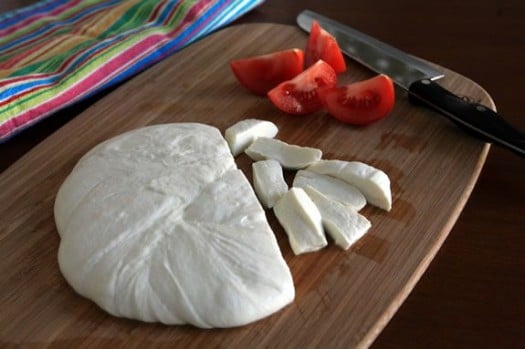
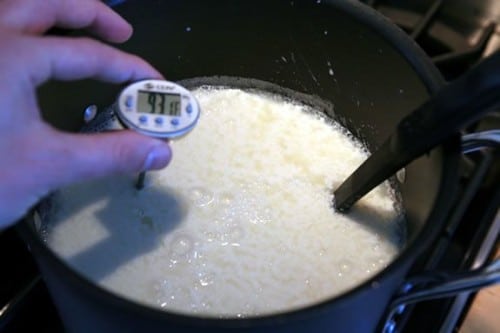
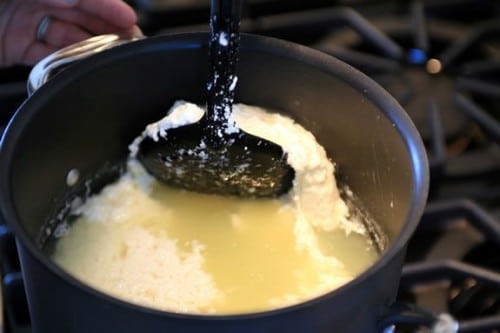
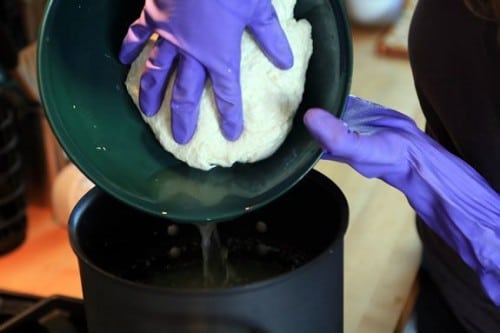
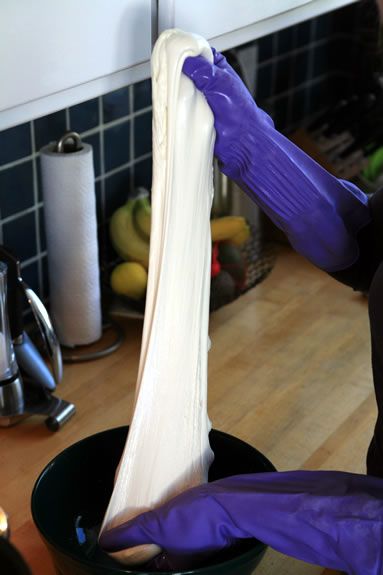

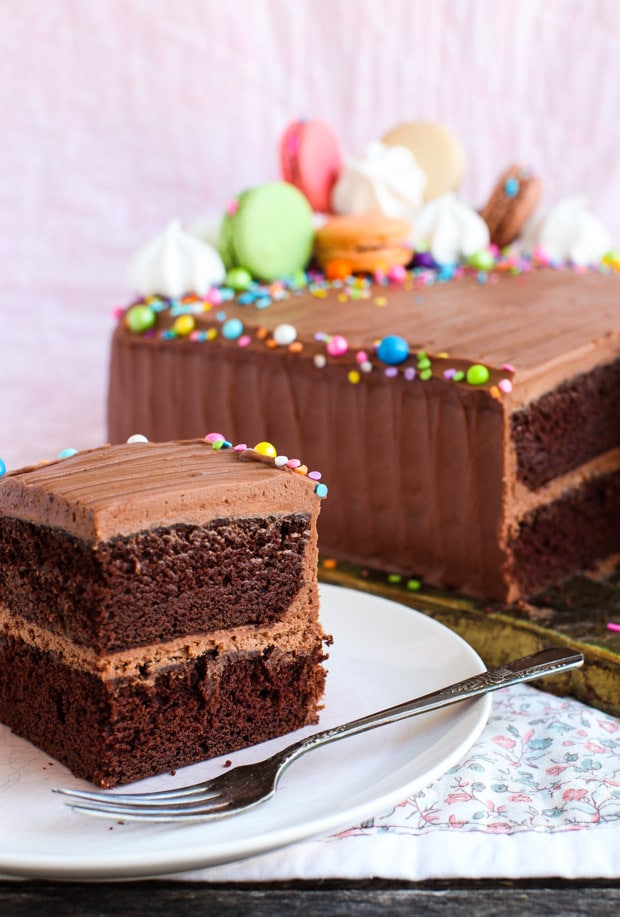
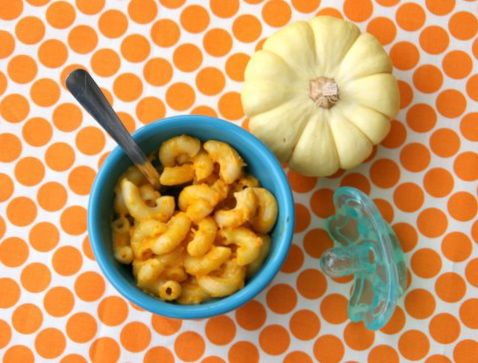

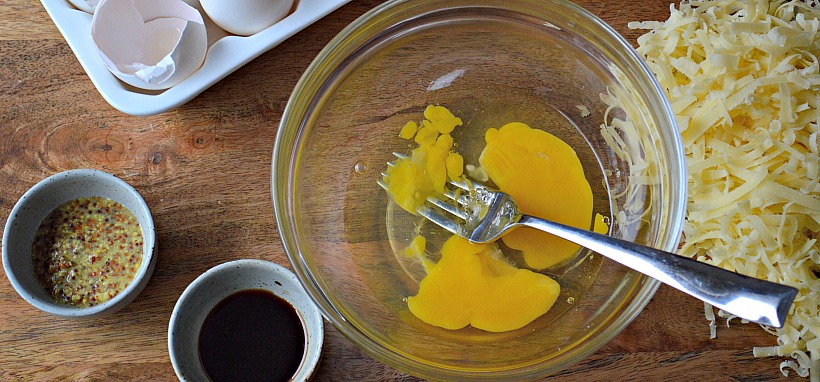
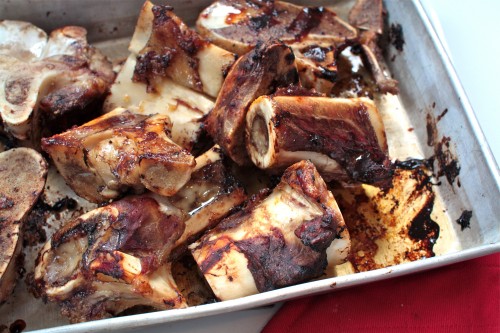
This is definitely happening at my next party. What a great idea!! Thanks! 🙂
Definitely something I’m going to have to try. Would the resulting cheese freeze and last in the freezer for a month or so?
This cheese is so yummy! We’ve been making it for years now. We (I have 4 kids) can eat the whole ball of cheese in one sitting.
Jason: It’s best fresh and warm—that’s its appeal. I think it would lose a lot if frozen, though I’ve never tried it. It might be okay for pizza, though?
I’ve made this several times and love it. My kids especially like it. I purchased a bunch of starters and we always have our own Creme Fraiche and a few others on hand! Great book!
I’m so-so happy about this tutorial. I have always wanted to try making my own mozz but was always intimidated by the process, this gives me courage and hope that I can do to
My kids love mozzarella, but I always end up in a mess whenever I try my hands at making it. This trick/tutorial should come very handy to me.
Thanks for sharing these wonderful tips. 🙂
-Alice
This looks like fun! Can the cheese be shredded or sliced to be used on pizza? I only ask since it’s a quick mozzarella…and maybe it wouldn’t do well in an oven?
I’ve never used it to make pizza, since we usually devour it right away, but I’d expect it would work well. I’d suggest refrigerating it for a few hours first, so it’ll firm up and then you can grate it. You’ll want to experiment a bit, but hey, that’s the fun part!
I think I need to give this a shot! I saw rennet at my grocery store and about fell over. Now I know what I’m going to do with it.
As far as the whey goes, it’s also perfect for making bread!
Great tip on baking bread with the whey, Kelly. So true.
I’m an Italian-American and I never knew that mozzarella could be made so easily. Thanks for enlightening me!
My daughter is really into cooking with me right now and would love this. I didn’t realize this could be done so easily.
LOVE homemade mozzarella. We haven’t always had a microwave available, so I end up heating up the whey and then doing the dip method, it takes longer – maybe an hour – but it is still delicious when it is done 😉
This is something I have to try very very soon. Thank you for this procedure, so well photographed and illustrated.
I’d love to try this! I already have the citric acid, so I’ll just have to locate the rennet!
What kind of gloves do you wear? Some one mentioned on another cheese making site the best type to avoid the heat when pulling cheese but it didn’t stick in my memory bank.
I just use some inexpensive dishwashing gloves that I picked up at the grocery store.
I love this! always wanted to try to make it at home. sounds awesome!
Any tips on times or temperatures when making it without a microwave? We don’t have one so I’d be doing it on the stovetop.
Andrew,
I LOVE mozzarella cheese, probably has something to do with being 1/8 Italian, right? 😉
My question is this: my hubby recently found out that he has a sensitivity to dairy. Which puts a real damper on my Italian dishes. I have seen a few goat cheese options, but they are either like feta, or soft. You say this can be made with goat’s milk, how does the process compare? And the taste and texture? I would love to actually like it enough to use to cook, or at least put his on his half of the pizza! (Of course, I will have to search around for goat’s milk, but I know it can be had.)
I’ve made it once with goat’s milk, and it came out great… turned out very similar to cow’s milk, except the flavor was a little bit, umm, goatier.
Re: lactose/dairy intolerance… look into a milk digestant/enzyme. It’s OTC and helps break down milk sugar:
http://www.puritan.com/lastase-enzymes-620?searchterm=lactase&rdcnt=1&sortorder=2&Page=1
Depending on the severity of your husband’s sensitivity, you can either try out different strengths or ask your doctor which strength would be better.
My dad is lactose intolerant and uses them as needed. Hope this helps…no one should have to give up dairy! IMO. Cheese is too tasty. =)
I know that my husband and daughter are both lactose intolerant, however they CAN do raw milk. Because nothings been done to it, it means none of the good stuff has been taken out so they can digest it just fine naturally! Give it a try with your husband! Then you can just use raw milk to make this recipe!
Good luck!
I am lactose intolerant and raw milk affects me exactly the same. It’s the lactase, which is in both pasteurized and unpasteurized milk that lactose intolerant folk are reacting to.
Pasteurization just heats the milk to kill off unwelcome bacteria, like listeria and salmonella and e. coli. It doesn’t do a darned thing to lactase.
I am also allergic to casein, which is a milk protein found in cows milk. Pasteurization doesn’t affect that either.
I just think it’s dangerous to tell people to drink raw milk to avoid lactose intolerance with all the debate about raw milk dangers when it doesn’t actually make a difference.
Yay! Love the photos:) and YUM.
Hi! Love this post and would love to try it. Do you know if using Lactaid or other lactose-free milk would work? thx!
Hi Tara! Thanks. I’m pretty sure the lactose-free milks won’t work… especially because they’ve been ultra-pasteurized (I know Lactaid-brand has been, not sure about others).
In cheesemaking, most of the lactose is expelled in the whey. Soft cheeses will still have some remaining lactose, though, so depending on your sensitivity it may still be an issue. (Mozzarella will be somewhere in the middle). Hard cheeses that have been aged a long time will have less… so maybe give Hook’s 15-year Cheddar a try! 😉
OMG you did it again. I am so motivated to make more cheese. After the last huge success with the lemon cheese, I can’t wait to see what happens with this one. Keep the cheese recipes coming!
This looks so fun!! Want to try this with the kids and my mom very soon. Thanks – great post!
It’s not real Mozzarella unless you use water buffalo milk.
How much mozzarella does this make? Over a pound? I really really want to make this now. hehe
Yep, it makes about a pound… give or take.
We drink raw cows milk. sometimes it starts to sour before we drink it all. Could the sour milk be used for making this since it is going to be curdling anyway?
Amazing! I make fresh ricotta for parties… Now I can get a whole cheese plate together. Im so excited to try it. Thank you!
I think I might make it just for the whey alone! I love baking with fresh whey. I am a big DIYer, but I never really considered making my own fresh mozzarella. Until now!
Nicole
If you’re having a hard time finding the citric acid, any beer making store will carry it.
I’ve been wanting to make my own cheese for a while now. Our neighbor down the road has cows… and fresh milk, and I think this will be wonderful!! Can’t wait to give it a try!
Taking everything to friends house to make and share with dinner tonight…adding to grape tomatoes, fresh basil and basamic sauce.
Great stuff, Sami! You’re sure to be popular at that party. 🙂
WOW. That’s incredible!!! What fantastic idea.
Great, great idea! I didn’t know you could even make this at home. Thanks for sharing!
My husband likes to make 30 minute Mozza. We’ve found that fresh unpasturized milk works better than store bought milk.
I just made this and it tastes great! I think I pulled it a bit much and it’s more stringier than I wanted, but overall a total success! Thanks for the easy recipe.
Curious! Might this work with soy milk? or coconut milk?
Sadly, no.
Oh whirl … it was worth a shot! Enjoy! It’s looks DELISH!
This sounds so good. Are the temps you give in Fahrenheit or Celsius?
Fahrenheit. 🙂
sorry for joining the party so late. (just found this shared on fb) but i am really confused about the temp. 55 degrees fahrenheit would require a refridgerator not a stove (i keep my house at 70!) while 55 Celsius would equal about 130 F, more akin to heating things…
other than that, looks great and i hope to try it soon!
thanks!
Since milk is kept cold (in the fridge), it’ll be starting at 35 degrees or so… so you’ll need to warm it up on the stove to 55 as part of this process.
Okay, I’m going to ask a stupid question here. If you’re using liquid rennet, do you still mix it with 1/4 cup water, or is that only if you’re using rennet in tablet form? I ask, because the directions say to add rennet “mixture” in the third step. I’m dying to try this over the weekend, and I don’t want to mess it up!
Not a stupid question! Yes, dilute the rennet (whether liquid or crushed tablet) in the water. That will help it distribute in the milk more evenly when you add it in.
Let us know how it turns out!
I couldn’t wait for the weekend- I made it last night! It took me 50 minutes instead of 30 (because there was a comedy of errors going on), and I’ve decided that investing in cheesecloth to strain the curds is a MUCH better idea that trying to scoop all of the curds out of the whey, but end result- FANTASTIC! I made cheese! Now that I know what I’m doing, I’m sure the next batch will fall really close to the 30-minute mark. Thanks so much for the great tutorial!
aa
how did you use the tomato and basil? Can’t wait to try it.
I would LOVE to try this, but living in Japan, I’m not sure if I can get the rennet or the citric acid. Do you know if the stuff they use to thicken tofu is the same as rennet? Can I use lemon juice or something in place of the citric acid? Please pardon my ignorance. I don’t know if this kind of stuff would get through customs (they are so strict here about food imports – we sent some plates once and they had to go through an extra inspection because they would be touching food!). I guess the only way to find out is to try it, though! 🙂
The coagulent for tofu is different than for cheese, so unfortunately it won’t work. You can use lemon juice to make cheese, but it probably won’t turn into mozzarella. You can give this recipe a try; all you need is lemon juice, milk, and salt.
http://www.eatingrules.com/2012/03/cheesemaking-challenge/
Is there a way to make this without a microwave?
Hi Jessica,
Yes, you can make this without a microwave! The best thing to do would be to use a double-boiler technique. You can use a large pot of hot (though not boiling!) water and then float a larger bowl in the hot water (metal, if possible) to heat it up that way.
Hope that helps!
Andrew thank you for sharing this recipe, I made the cheese yesterday and it was delicious. My friends and family were very impressed. I did run into an elasticity problem which required me to microwave the cheese several more times, I probably needed to melt it more but was concerned I would over heat it. I used whole milk from the grocery store but now will search for a good dairy to capture the better tasting milk flavor. Thanks again!
I use raw milk from the local farmer’s market, but I’ll probably skim some of the fat off or it might be too soft for my taste. I guess I’ll be busy making this and homemade french bread tomorrow!
I just made this and I nervous, started out good, then I didn’t see my milk curdle. When it was time to scoop out the cheese I had succeeded and there was huge chunks, so I got all of it scooped out and mostly drained and kept doing the microwave thing. It went bad about the time I added the salt and now it’s choppy and looks like riccotta cheese there is no string or rubbery affect. Did I not succeed in pouring off the whey or did the addition of the salt mess it up? Will be trying again but not sure what happened…
Hi Dana,
Did you let the curds sit for about 5 minutes before scooping them out into the bowl? Though it sounds more like the curds did not quite get hot enough from the microwaving step. Or, maybe you overheated them? They should basically get hot enough to melt together and then become stretchy like taffy — if they break when you try to stretch them they’re not hot enough.
What kind of milk were you using? Did it say “Pasteurized” or “Ultra-Pasteurized”? (Ultra- won’t work properly).
Hope that helps!
I use pasteurized 2% milk, I did some of my own research and I believe it was over heated in the microwave and I was afraid to fold the cheese too much, so I will try again today. And I also did let the mixture set for the 5 minutes before getting the curds out. Thank you for replying to my questions!
Hi Andrew,
Thank you so much for sharing this great recipe, I was so excited when I found this. The first time I tried this, I used whole milk, but my texture turned out a little more like ricotta or a feta, still tasted great but not a mozzarella texture at all. I was not ready to admit defeat so I tried again with raw whole milk from my dad’s dairy farm. It came out perfect! I was so excited! However, it made such a small amount. I can’t figure out how a gallon of milk could only make so little, it made maybe 12 oz. at the most. In the picture of yours, it looked like you had a lot more than that. Did you ever find that it made more or less in different batches? Also, approximately how many ounces do you think yours makes?
Hi Colleen! I’m guessing your first batch of milk was pasteurized at too high a temperature (though perhaps not ultra-pasteurized — if it’s UP it probably wouldn’t even curdle). Since pasteurization only requires minimum times/temperatures, companies may sometimes overdo it.
As for your second batch, was the whey yellowish-clear when you ladled out the curds? If it was still milky/cloudy, that could account for some of the loss. I have never actually weighed the final product, but I’d guess it’s about a pound (16 ounces). Hope that helps!
I also wanted to add don’t throw away your whey! You can use the leftovers for all sorts of fabulous things. The list includes:
Smoothies
In your garden
For your pets (gives them protein)
In biscuits
Here’s a great convo on Chowhound I found about using the leftovers!
http://chowhound.chow.com/topics/549139
Andrew, I just wanted to let you know I included a link to your fine tutorial in my April blog roundup: http://squarepennies.blogspot.com/2012/05/april-blog-round-up-april-flowers.html
This is so cool and I can’t wait to try it. Thanks for sharing!
Thank you, Andrew, for sharing this recipe. Do you know why citric acid and rennet are used? How do those two ingredients help in the process? I’m just curious, that’s all, I’ve never made cheese or known of anyone who makes their own. 🙂
They are the coagulent agents — so that’s what causes the milk to curdle. To be honest, I’m not quite sure why, exactly, it’s both for this recipe… but I do know that it works well! 🙂
What an interesting and informative blogpost. I\’m really looking forward to trying this.
So…this didn’t work for me. So sad. My milk never really curdled. I used RAW, goats milk from the farm…. so bummed.
where u buy rennet pills? tks
I buy my rennet from http://cheesemaking.com . They have a few options, and I use the liquid vegetarian rennet.
So it sounds good and all but let me ask you this question. Why couldn’t you just start with cottage cheese and skip the whole milk thing and go right to the micro? is that possible?
Good idea, but unfortunately it won’t work – the curds are going to be too firm (since they’ve continued to expel whey since it was made — the liquid that appears at the top of the container), and they won’t melt/knit together and get stretchy. (I’m not sure what happens when you heat cottage cheese – I don’t think I’ve actually tried it – but I’m pretty sure the end result won’t be all that appealing. Let me know if you try it and I’m wrong, though!) 🙂